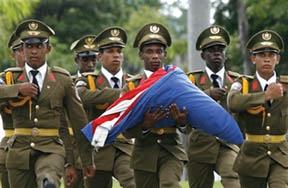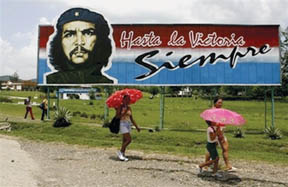|
observer |
|
|
|
|
|
OTHER LINKS |

|

|

|
Roots of Cuban revolution lie in the east
It was the summer of 1953, and dozens of young men and women huddled before dawn in a red-and-white farmhouse listening to a young Fidel Castro detail their impossible mission. The Cuban revolution was born that July 26 when the group attacked the Moncada military barracks in the eastern city of Santiago. Though the assault failed and many militants died, Castro went on to oust his nemesis, dictator Fulgencio Batista. Fifty-three years later and just weeks from his 80th birthday, President Castro is returning to eastern Cuba with his legacy very much in mind. His mission now is to remind Cubans of the sacrifices that brought them this far, and show the revolution lives on. Talk of what will happen after Fidel is gone is creeping into public discussion here as his Aug. 13 birthday nears. Cuban officials are strengthening the Communist Party to ensure the system survives far into the future. The president's designated successor is his 75-year-old brother, Defense Minister Raul Castro, who also participated in the Moncada attack.
Fidel Castro is expected to commemorate the roots of the revolution Wednesday in Bayamo by honoring another key event: It was 50 years ago that an overloaded yacht - called Granma in honor of a previous owner's grandmother - landed in eastern Cuba. On board were the Castro brothers and 80 other men who had formed a rebel army in Mexico after being freed from prison in an amnesty following Moncada. Like Moncada, the Granma landing at first seemed a disaster. Of the 82 people aboard, only 12 survived the landing and initial skirmishes with Batista's forces in December 1956. Among the survivors were the two Castro brothers and Ernesto "Che" Guevara, who headed for the hills to build a command post for the revolution that drove Batista from power and out of Cuba on Jan. 1, 1959. Castro now lives and governs far to the west in Havana, but it was here in Cuba's east that he was born, reared and began the revolution that reshaped the country into a communist state. Even now, he represents the eastern city of Santiago in Cuba's parliament. Cuba's eastern cities are dotted with statues of heroes of the revolution, and of men who fought and died here for Cuba's independence from Spain. Known as Oriente Province at the time of Castro's revolution, it has since been renamed Granma, and Bayamo is its capital. The Moncada itself now houses a museum and an elementary school, where children laugh and play outside an exhibit showing implements used to torture political prisoners. The Siboney farm, too, is a museum. Exhibits show how Castro's No. 2 man, Abel Santamaria, turned the property into a fake chicken farm, building coops to hide cars used in the attack. Weapons were smuggled in chicken feed bags, then stored in the farmhouse's ceilings and a well outside. Castro planned to lead a group in storming the Moncada barracks and seizing weapons while two other groups fired on the building from a nearby hospital and the Palace of Justice. Dozens of recruits traveled to eastern Cuba by bus and train from Havana, posing as revelers headed to Santiago's summer carnival. Most didn't know the mission's details until the night before the attack. Of the 129 gathered at the farmhouse the night of July 25, 10 opted out after hearing Castro's plan. The morning's first error came as some of the cars mistakenly took the road toward Havana instead of Santiago. The assailants who arrived at Moncada surprised the first guard post, but a guard spotted them and rang the alarm, rousing troops to face the outnumbered and outgunned rebels. Castro aborted the attack, and many assailants retreated to the farmhouse and surrounding mountains. But others, unaware of the order to retreat, kept fighting and were either killed or captured. Santamaria was tortured and killed. Castro and his brother were imprisoned. Former combatant Francisco Betancourt, now 71, was stoic during a recent visit to the jail cell where he was held temporarily at Moncada. But tears welled up when he talked about comrades picked up by police and never seen again. Betancourt didn't participate in the Moncada attack, but like many Cubans, he was inspired by the assault. With Castro behind bars, Betancourt was among the students, peasants and workers who gathered under the leadership of Frank Pais to continue the July 26 fight. Santiago residents hid Betancourt after he helped attack a police station on Nov. 30, 1956. He was eventually caught and tortured. Pais was gunned down by police in Santiago on July 30, 1957. Betancourt and many older Cubans still embrace the ideals of justice and equality that inspired the militants that July 26. Others disillusioned with what became of those ideals fled to Florida. Fifty years on, Betancourt said he is saddened by Cubans who fail to recognize the revolution's advances toward racial and social equality. Many younger Cubans focus on what they don't have - such as big salaries - even while embracing free education and universal health care. "The benefits we have today didn't fall out of the sky, they were won," said Betancourt. "Many people died for this," he said. "And those who always look for the negative, well, it's like giving someone a plate of food and having your hand bitten." |










